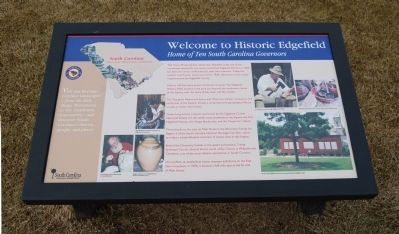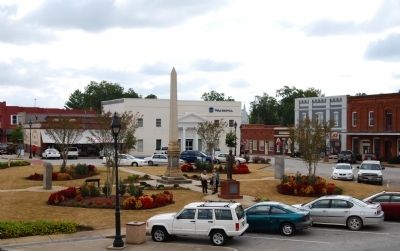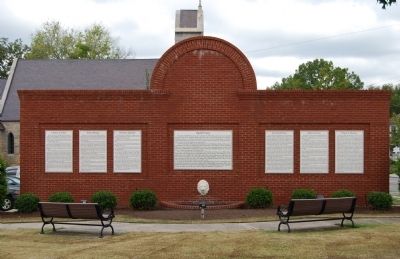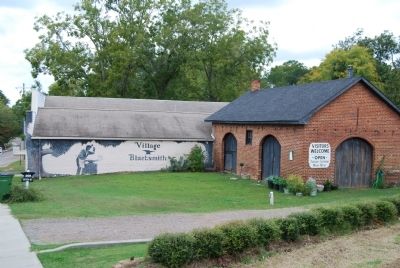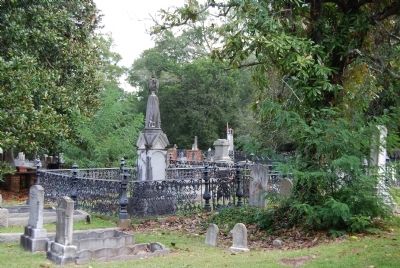Edgefield in Edgefield County, South Carolina — The American South (South Atlantic)
Welcome to Historic Edgefield
Home to Ten South Carolina Governors
This Court House Square, which was identified as the site of the courthouse and jail for the newly established Edgefield District in 1785, has been the center of life here for over two centuries. Today the present courthouse, which was built in 1839, still serves as the center of government for Edgefield County.
Visitors will find many points of interest close by. The Edgefield History Wall, located in the park just beyond the northwest corner of the Square tells the story of the town and the county.
The Tompkins Memorial Library and Welcome Center, located on the north side of the Square, houses a comprehensive genealogical library as well as visitor information.
Three living history projects sponsored by the Edgefield Historical Society are also within close proximity to the Square: the Old Edgefield Pottery, the Village Blacksmith, and the Carpenter's Stand.
Three blocks to the east on Main street is the Discovery Center for Region 2 of the South Carolina National heritage Corridor, which provides a comprehensive overview of tourist sites in this Region.
Behind the Discovery Center is the quaint and historic Trinity Episcopal Church. Several blocks north of the church is Willowbrook Cemetery, one of the most historic cemeteries in South Carolina.
Oakley Park, an antebellum house museum and shrine to the Red Shirt movement of 1876, is located a half mile east at the far end of Main Street.
Erected by South Carolina Heritage Corridor.
Topics and series. This historical marker is listed in these topic lists: Cemeteries & Burial Sites • Churches & Religion • Industry & Commerce • Law Enforcement • Parks & Recreational Areas • Settlements & Settlers. In addition, it is included in the South Carolina Heritage Corridor series list. A significant historical year for this entry is 1785.
Location. 33° 47.367′ N, 81° 55.767′ W. Marker is in Edgefield, South Carolina, in Edgefield County. Marker is on Courthouse Square. Marker is in the northwest section of court square. Touch for map. Marker is in this post office area: Edgefield SC 29824, United States of America. Touch for directions.
Other nearby markers. At least 10 other markers are within walking distance of this marker. Governors and Lieutenant Governors from Edgefield (here, next to this marker); Lynch Building (within shouting distance of this marker); First Term of Court (within shouting distance of this marker); Edgefield County World War I Memorial (within shouting distance of this marker); Edgefield County Veterans Memorial (within shouting distance of this marker); Edgefield County Confederate Monument
(within shouting distance of this marker); a different marker also named Welcome to Historic Edgefield (within shouting distance of this marker); J. Strom Thurmond (within shouting distance of this marker); The Booth-Toney Shootout of 1878 (within shouting distance of this marker); Israel Mukashy Building (within shouting distance of this marker). Touch for a list and map of all markers in Edgefield.
Also see . . . Edgefield Historic District. As early as 1787, the village green near Court House Square was deeded to the town of Edgefield. (Submitted on August 9, 2009, by Brian Scott of Anderson, South Carolina.)
Additional commentary.
1. Edgefield Historic District
Edgefield developed around Court House Square, village green deeded to the town in 1787. Several significant buildings surrounding the landscaped square remain unaltered, and the initial layout of town has not changed. More than forty 19th century buildings are within the historic area, including three house museums.
There are a number of 19th century Greek Revival home with large central halls and the basic
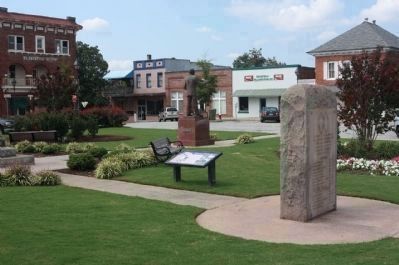
Photographed By Mike Stroud, 2011
3. Welcome to Historic Edgefield Marker
Located in Court House Square, "Governors and Lieutenant Governors from Edgefield" and "Strom Thurmond" Monuments also seen here.
(See nearby markers)
National Register of Historic Places: Edgefield Historic District ** (added 1972 - - #72001207)
National Register of Historic Places: Edgefield Historic District ** (added 1972 - - #72001207)
Five churches (Episcopal, Baptist, Catholic, Presbyterian and Methodist) represent Georgian, Victorian Gothic, and modified Gothic architecture styles.
1. Trinity Episcopal Church – Built 1836. Red-brick building with central tower. Octagonal belfry surmounted by spire with cross.
2. St. Mary’s Catholic Church – Cornerstone laid February 10, 1858. Designed by John R. Niernsee, architect of the South Carolina State House. Granite exterior with buttresses.
3. Episcopal Rectory – Built 1826. Raised-cottage style. Beautiful semielliptical fanlight over double-door entrance.
4. Willowbrook Cemetery – Distinguished South Carolinians buried here include: Francis W. Pickens, John Gary Evans, Francis Hugh Wardlaw, Preston Brooks, and Matthew C. Butler.
5. Edgefield County Court House – Built c. 1839. Red-brick exterior. Greek Revival portico supported by four Tuscan columns. Portraits of significant lawyers and judges on display here.
6. Halcyon Grove – Built 1815 by Andrew Pickens, Jr., who lived here while serving as governor (1816-1818). Architect features include unusual lattice columns and double-tiered piazza.
7. Mims-Norris House – Built 1818. Continuously occupied by six generations of the original family.
8. Magnolia Dale – Built 1830 by Connecticut architect who followed typically South Carolina antebellum floor plan of central hall with two rooms on each side. Front portico supported by four, fluted Tuscan columns.
9. Holmewood – Built 1834 by Dr. William Prothro. Owned by Francis Hugh Wardlaw, one of the drafters of the Ordinance of Secession. Greek Revival with white clapboard exterior. Six columns support front portico. Double-door entrance with semicircular fanlight.
10. Oakley Park – Built 1835 by Daniel Byrd. Owned by General Martin W. Gary, the “Bald Eagle of the Confederacy.” Presently used as house museum and shrine to Red Shirts sponsored by the United Daughters of the Confederacy.
Significance
Politically, militarily, and agriculturally significant, Edgefield has been an influential community since its founding and has served as county seat since 1791. Its tree-lined streets provide an ideal setting for architecturally significant antebellum buildings.
First permanent settlers of the Edgefield area arrived in the 1760s from Pennsylvania, Virginia, North Carolina, the South Carolina Lowcountry, England, and Scotland. By the 1780s the village of Edgefield had developed into the commercial center for the district with a number of silversmiths, cabinet makers and artisans.
Much of Edgefield’s significance results from its large number of important political figures: ten former South Carolina governors; five lieutenant-governors; several U.S. Congressmen and Senators including Benjamin Ryan Tillman, Preston Brooks, and Strom Thurmond.
Militarily, the Edgefield area was important during the Revolution due to its vital location on the route between British-held Augusta and British-held Ninety Six. Important patriots of the area were the Hammonds, Simkins, Butlers and Middletons. Edgefield leadership in U.S. military life continued in the Mexican War with such outstanding men as Colonels William B. Travis, James Bonham, and Pierce M. Butler. During the Confederate and Spanish-American Wars, Edgefield furnished many distinguished generals. In Reconstruction days, Oakley Park, Edgefield plantation owned by General Martin W. Gary, was site of organization of the Red Shirts.
As commercial center for the area’s many cotton plantations Edgefield has been vitally involved in agriculture. By 1823 there was an active society
in Edgefield devoted to improving agricultural processes.
The Edgefield Advertiser, published since 1836, is South Carolina’s oldest newspaper with continued legal identity.
Schools flourished in rural areas as well as in town. Furman University was first established here and later moved to Greenville. Edgefield Female Academy, under the administration of William B. Johnson (first president of the Southern Baptist Convention), provided educational facilities for the young ladies of the area.
After the 1830s, plantation churches gradually moved into town. Edgefield Baptist Church, constituted 1784, contributed significantly to the organization of the Southern Baptist Convention and produced the convention’s first president. The Lutheran, Episcopal, Catholic and Methodist denominations have been active in Edgefield since the 18th century; however, the Presbyterian church was established later (1877). (Source: National Register nominatior form.)
— Submitted August 9, 2009, by Brian Scott of Anderson, South Carolina.
2. Correction about Holmewood.
The above information about Holmewood, in the Additional Comments section above, was quoted from the National Register of Historic Places Nomination form (ca. 1972). Since then, more accurate details of Holmewood
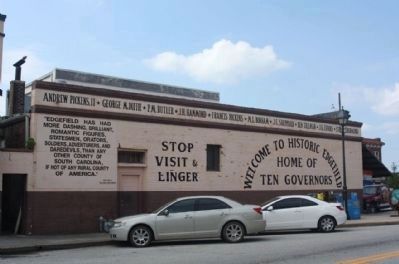
Photographed By Mike Stroud, 2011
7. Stop Visit & Linger
Andrew Pickens, II * George McDuffie
* P.M. Butler * J.H. Hammond
* Francis Pickins * M.L. Bonham
* J.C. Sheppard * Ben Tillman
* J.G. Evans * Strom Thurmond
" Edgefield has had
more dashing, brilliant,
romantic figures,
statesmen, orators,
soldiers, adventurers, and
daredevils, than any
other county of
South Carolina,
if not any rural county
of America."
W.W. Ball
The State That Forgot
Holmewood was built before 1834. The greater part of its planning and construction probably occurred in the period 1825-1827. It was occupied by the Prothro family as early as 1832. William Prothro was a prominent planter, timberman, mill owner, and business man, but he was NOT a doctor, medical or otherwise.
Neither was he ever married to Arthur Simkins' granddaughter, Sarah Ann Lowe, as is often stated elsewhere. Sarah Ann actually married one of William Prothro sons, and died soon after the marriage.
A more accurate description would be:
Holmewood – Built between 1827-32 by William Prothro. Owned by Francis Hugh Wardlaw, one of the drafters of the Ordinance of Secession. Greek Revival with white clapboard exterior. Six columns support front portico. Double-door entrance with semicircular fanlight.
— Submitted September 7, 2010, by George Prothro Coulter of Altadena, California.
Credits. This page was last revised on February 2, 2020. It was originally submitted on October 18, 2008, by Brian Scott of Anderson, South Carolina. This page has been viewed 3,314 times since then and 21 times this year. Photos: 1, 2. submitted on October 18, 2008, by Brian Scott of Anderson, South Carolina. 3. submitted on September 26, 2011, by Mike Stroud of Bluffton, South Carolina. 4, 5, 6. submitted on October 18, 2008, by Brian Scott of Anderson, South Carolina. 7. submitted on September 26, 2011, by Mike Stroud of Bluffton, South Carolina.
